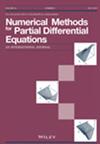Experimental convergence rate study for three shock‐capturing schemes and development of highly accurate combined schemes
IF 1.7
3区 数学
Q1 MATHEMATICS, APPLIED
引用次数: 0
Abstract
Abstract We study experimental convergence rates of three shock‐capturing schemes for hyperbolic systems of conservation laws: the second‐order central‐upwind (CU) scheme, the third‐order Rusanov‐Burstein‐Mirin (RBM), and the fifth‐order alternative weighted essentially non‐oscillatory (A‐WENO) scheme. We use three imbedded grids to define the experimental pointwise, integral, and convergence rates. We apply the studied schemes to the shallow water equations and conduct their comprehensive numerical convergence study. We verify that while the studied schemes achieve their formal orders of accuracy on smooth solutions, after the shock formation, a part of the computed solutions is affected by shock propagation and both the pointwise and integral convergence rates reduce there. Moreover, while the convergence rates for the CU and A‐WENO schemes, which rely on nonlinear stabilization mechanisms, reduce to the first order, the RBM scheme, which utilizes a linear stabilization, is clearly second‐order accurate. Finally, relying on the conducted experimental convergence rate study, we develop two new combined schemes based on the RBM and either the CU or A‐WENO scheme. The obtained combined schemes can achieve the same high order of accuracy as the RBM scheme in the smooth areas while being non‐oscillatory near the shocks.三种激波捕获方案的实验收敛率研究及高精度组合方案的开发
摘要研究了具有守恒定律的双曲型系统的三种激波捕获方案的实验收敛速率:二阶中心迎风(CU)方案、三阶Rusanov - Burstein - Mirin (RBM)方案和五阶可选加权本质非振荡(A - WENO)方案。我们使用三个嵌入网格来定义实验的逐点、积分和收敛速率。我们将所研究的格式应用于浅水方程,并对其进行了全面的数值收敛研究。我们验证了虽然所研究的格式在光滑解上达到了它们的形式精度阶,但在激波形成后,部分计算解受到激波传播的影响,并且点向和积分收敛速度都降低了。此外,CU和A‐WENO方案的收敛率降低到一阶,而采用线性稳定机制的RBM方案明显具有二阶精度。最后,基于已进行的实验收敛速率研究,我们开发了基于RBM和CU或A‐WENO方案的两种新的组合方案。所得到的组合格式可以在光滑区域获得与RBM格式相同的高阶精度,同时在冲击附近无振荡。
本文章由计算机程序翻译,如有差异,请以英文原文为准。
求助全文
约1分钟内获得全文
求助全文
来源期刊
CiteScore
7.20
自引率
2.60%
发文量
81
审稿时长
9 months
期刊介绍:
An international journal that aims to cover research into the development and analysis of new methods for the numerical solution of partial differential equations, it is intended that it be readily readable by and directed to a broad spectrum of researchers into numerical methods for partial differential equations throughout science and engineering. The numerical methods and techniques themselves are emphasized rather than the specific applications. The Journal seeks to be interdisciplinary, while retaining the common thread of applied numerical analysis.

 求助内容:
求助内容: 应助结果提醒方式:
应助结果提醒方式:


